| |
 |
 |
 |
|
 |
 |
 |
 |
 |

|
 |
 |
|
|
|
 |
Evidence of a "Lost World": Antarctica Yields Two Unknown Dinosaur Species
|
 |
| |
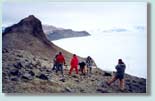 Against incredible odds, researchers working in separate sites, thousands of miles apart in Antarctica have found what they believe are the fossilized remains of two species of dinosaurs previously unknown to science. One of the two finds, which were made less than a week apart, is an early carnivore that would have lived many millions of years after the other, a plant-eating beast, roamed the Earth. One was found at the sea bottom, the other on a mountaintop. Against incredible odds, researchers working in separate sites, thousands of miles apart in Antarctica have found what they believe are the fossilized remains of two species of dinosaurs previously unknown to science. One of the two finds, which were made less than a week apart, is an early carnivore that would have lived many millions of years after the other, a plant-eating beast, roamed the Earth. One was found at the sea bottom, the other on a mountaintop.
Credit: NSF photo
Read the full story. ... Posted
2/26/04
|
 |
Large Diamonds Made from Gas Are Hardest Yet
|
 |
| |
 Producing a material that is harder than natural diamond has been a goal of materials science for decades. Now a group headed by scientists at the Carnegie Institution's Geophysical Laboratory in Washington, D.C., has produced gem-sized diamonds that are harder than any other crystals and at a rate up to 100 times faster than other methods used to date. The process opens up an entirely new way of producing diamond crystals for electronics, cutting tools and other industrial applications. "We believe these results are major breakthroughs in our field," said Chih-shiue Yan, lead author of the study published in the Feb. 20, online Physica Status Solidi. "Not only were the diamonds so hard they broke the measuring equipment, we were able to grow gem-sized crystals in about a day." Producing a material that is harder than natural diamond has been a goal of materials science for decades. Now a group headed by scientists at the Carnegie Institution's Geophysical Laboratory in Washington, D.C., has produced gem-sized diamonds that are harder than any other crystals and at a rate up to 100 times faster than other methods used to date. The process opens up an entirely new way of producing diamond crystals for electronics, cutting tools and other industrial applications. "We believe these results are major breakthroughs in our field," said Chih-shiue Yan, lead author of the study published in the Feb. 20, online Physica Status Solidi. "Not only were the diamonds so hard they broke the measuring equipment, we were able to grow gem-sized crystals in about a day."
Credit: Image used with permission of Physica Status Solidi
Read the full story . ... Posted
2/26/04
|
 |
A Lost World: Two Previously Unknown Dinosaurs Discovered in Antarctica
|
 |
| |
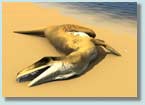 The National Science Foundation (NSF) invites members of the news media to hear about the discoveries of fossils of two dinosaurs believed to be new to science. Against incredible odds, researchers working in separate sites, thousands of miles apart in Antarctica, recently found what they believe are the fossilized remains of an early plant-eating dinosaur and a meat-eater related to Tyrannosaurus Rex. NSF-funded scientists from universities in California, South Dakota, and Illinois, whose research was supported by the U.S. Antarctic Program, will describe the highly unusual circumstances involved in making their finds and the significance of the finds to other dinosaur research. The event will be webcast live on Thursday, February 26, 2004, starting at 1pm, Eastern Time. The National Science Foundation (NSF) invites members of the news media to hear about the discoveries of fossils of two dinosaurs believed to be new to science. Against incredible odds, researchers working in separate sites, thousands of miles apart in Antarctica, recently found what they believe are the fossilized remains of an early plant-eating dinosaur and a meat-eater related to Tyrannosaurus Rex. NSF-funded scientists from universities in California, South Dakota, and Illinois, whose research was supported by the U.S. Antarctic Program, will describe the highly unusual circumstances involved in making their finds and the significance of the finds to other dinosaur research. The event will be webcast live on Thursday, February 26, 2004, starting at 1pm, Eastern Time.
Credit: Trent L. Schindler / National Science Foundation
Event details . ... Posted
2/24/04
|
 |
Fuel-Cell Microbes' Double Duty: Treat Water, Make Energy; NSF 'sugar' grant supports single-chamber prototype fed by wastewater
|
 |
| |
 Something big may be brewing on the sewage-treatment circuit thanks to a new design that puts bacteria on double duty - treating wastewater and generating electricity at the same time. The key is an innovative, single-chambered microbial fuel cell. The prototype is described in the online version of the journal Environmental Science & Technology. A fuel cell operates akin to a battery, generating electricity from a chemical reaction. But instead of running down unless it's recharged, the cell receives a constant supply of fuel from which electrons can be released. Typical fuel cells run off of hydrogen. In a microbial fuel cell, bacteria metabolize their food—in this case, organic matter in wastewater—to release electrons that yield a steady electrical current. The single-chambered prototype, developed by researchers at Pennsylvania State University with support from NSF, allows the process to work efficiently in wastewater. Something big may be brewing on the sewage-treatment circuit thanks to a new design that puts bacteria on double duty - treating wastewater and generating electricity at the same time. The key is an innovative, single-chambered microbial fuel cell. The prototype is described in the online version of the journal Environmental Science & Technology. A fuel cell operates akin to a battery, generating electricity from a chemical reaction. But instead of running down unless it's recharged, the cell receives a constant supply of fuel from which electrons can be released. Typical fuel cells run off of hydrogen. In a microbial fuel cell, bacteria metabolize their food—in this case, organic matter in wastewater—to release electrons that yield a steady electrical current. The single-chambered prototype, developed by researchers at Pennsylvania State University with support from NSF, allows the process to work efficiently in wastewater.
Credit: Trent L. Schindler / National Science Foundation
Read the full story . ... Posted
2/24/04
|
 |
A Change at the Top for NSF
|
 |
| |
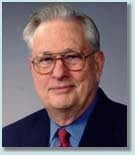 Arden L. Bement, Jr., became Acting Director of the National Science Foundation on February 22, 2004. He joins NSF from the National Institute of Standards and Technology, where he has been director since Dec. 7, 2001. Prior to his appointment as NIST director, Bement served as the David A. Ross Distinguished Professor of Nuclear Engineering and head of the School of Nuclear Engineering at Purdue University. He has held appointments at Purdue University in the schools of Nuclear Engineering, Materials Engineering, and Electrical and Computer Engineering, as well as a courtesy appointment in the Krannert School of Management. Arden L. Bement, Jr., became Acting Director of the National Science Foundation on February 22, 2004. He joins NSF from the National Institute of Standards and Technology, where he has been director since Dec. 7, 2001. Prior to his appointment as NIST director, Bement served as the David A. Ross Distinguished Professor of Nuclear Engineering and head of the School of Nuclear Engineering at Purdue University. He has held appointments at Purdue University in the schools of Nuclear Engineering, Materials Engineering, and Electrical and Computer Engineering, as well as a courtesy appointment in the Krannert School of Management.
Photo courtesy: NIST
Read the full story . ... Posted
2/23/04
|
 |
Critical Lessons from September 11th; Insight into research at Ground Zero, presented by the researchers who were there
|
 |
| |
 Within days of the September 11th attacks, unseen by the public and below the radar screens of many in the media, the U.S. academic community was scrambling. Rapid-response researchers, driven by years of experience studying earthquake and flood disasters, now rushed to collect critical data from Ground Zero before information was lost forever. On Monday, Feb. 23, 2004, the National Science Foundation will host six of the nation's top rapid-response researchers as they shed light on their experiences at Ground Zero, the current state of disaster studies and the recent compilation of the research findings, Beyond September 11th: An Account of Post-Disaster Research. Within days of the September 11th attacks, unseen by the public and below the radar screens of many in the media, the U.S. academic community was scrambling. Rapid-response researchers, driven by years of experience studying earthquake and flood disasters, now rushed to collect critical data from Ground Zero before information was lost forever. On Monday, Feb. 23, 2004, the National Science Foundation will host six of the nation's top rapid-response researchers as they shed light on their experiences at Ground Zero, the current state of disaster studies and the recent compilation of the research findings, Beyond September 11th: An Account of Post-Disaster Research.
Photo courtesy: Andrea Booher/FEMA News Photo
Read the full story . ... Posted
2/18/04
|
 |
Rita Colwell to Leave National Science Foundation
|
 |
| |
 National Science Foundation Director Rita R. Colwell will assume the position of Chairman of Canon U.S. Life Sciences, Inc. upon her retirement from the Foundation, effective February 21, 2004. Canon U.S. Life Sciences is a newly created, Washington-based subsidiary of Canon U.S.A., Inc. whose goal is to identify and develop life-science solutions with potential applications in diagnostics and medical instrumentation. Dr. Colwell, a microbiologist and internationally recognized expert on cholera and other infectious diseases, will also serve as Distinguished University Professor at the University of Maryland, College Park, and on the faculty of The John Hopkins Bloomberg School of Public Health, where she will help develop a new international center for the study of infectious diseases, water, and health in conjunction with scientific colleagues from Sweden, Norway, Japan, and Bangladesh. "I am extremely grateful to have had the opportunity to lead NSF through two Administrations and major transformational changes," Colwell said. National Science Foundation Director Rita R. Colwell will assume the position of Chairman of Canon U.S. Life Sciences, Inc. upon her retirement from the Foundation, effective February 21, 2004. Canon U.S. Life Sciences is a newly created, Washington-based subsidiary of Canon U.S.A., Inc. whose goal is to identify and develop life-science solutions with potential applications in diagnostics and medical instrumentation. Dr. Colwell, a microbiologist and internationally recognized expert on cholera and other infectious diseases, will also serve as Distinguished University Professor at the University of Maryland, College Park, and on the faculty of The John Hopkins Bloomberg School of Public Health, where she will help develop a new international center for the study of infectious diseases, water, and health in conjunction with scientific colleagues from Sweden, Norway, Japan, and Bangladesh. "I am extremely grateful to have had the opportunity to lead NSF through two Administrations and major transformational changes," Colwell said.
Read the full story . ... Posted
2/11/04
|
 |
NSF Fiscal 2005 Budget Request Is $5.745 Billion
|
 |
| |
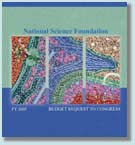 The National Science Foundation (NSF) today submitted to Congress a $5.745 billion budget request for fiscal year 2005. Foundation Director Rita Colwell says the funds will "address frontiers of knowledge and innovation that will strengthen economic growth and prosperity nationally." The 3 percent overall increase above the fiscal 2004 amount the president recently signed into law will allow NSF to continue support of its integrative research and education investments, Colwell stated. Further, the 2005 request increases funding specifically for research and related activities by 4.7 percent over the current-year level. The National Science Foundation (NSF) today submitted to Congress a $5.745 billion budget request for fiscal year 2005. Foundation Director Rita Colwell says the funds will "address frontiers of knowledge and innovation that will strengthen economic growth and prosperity nationally." The 3 percent overall increase above the fiscal 2004 amount the president recently signed into law will allow NSF to continue support of its integrative research and education investments, Colwell stated. Further, the 2005 request increases funding specifically for research and related activities by 4.7 percent over the current-year level.
Image: © 2002 David S. Goodsell, Scripps Research Institute
Read the full story . ... Posted
2/2/04
|
 |
Microbial Biofilm Yields Community Genomes, Metabolic Clues; Research from Iron Mountain mine sheds light on acid drainage
|
 |
| |
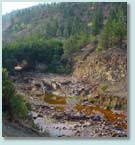 Examining life extracted from toxic runoff at a northern California mine, researchers for the first time have reconstructed multiple individual genomes from a microbial community taken from an environmental sample rather than from a laboratory culture. According to Jill Banfield, the leader of the scientific team behind the discovery, "This takes the study of natural biogeochemical systems to a new level." Announced Feb. 1 in the online version of the journal Nature, the research focused on a sample from a postage-stamp-sized patch of pink biofilm taken from a thin microbial layer found growing hundreds of feet underground. (Often slimy, biofilms are communities of microorganisms—such as bacteria and fungi—that grow on surfaces. Think of a kitchen sink left unwiped.) The research team found its biofilm atop a hot, flowing, extremely acidic solution—laden with dissolved iron, copper, zinc and arsenic—emanating from a mine on Iron Mountain, about nine miles northwest of Redding. Examining life extracted from toxic runoff at a northern California mine, researchers for the first time have reconstructed multiple individual genomes from a microbial community taken from an environmental sample rather than from a laboratory culture. According to Jill Banfield, the leader of the scientific team behind the discovery, "This takes the study of natural biogeochemical systems to a new level." Announced Feb. 1 in the online version of the journal Nature, the research focused on a sample from a postage-stamp-sized patch of pink biofilm taken from a thin microbial layer found growing hundreds of feet underground. (Often slimy, biofilms are communities of microorganisms—such as bacteria and fungi—that grow on surfaces. Think of a kitchen sink left unwiped.) The research team found its biofilm atop a hot, flowing, extremely acidic solution—laden with dissolved iron, copper, zinc and arsenic—emanating from a mine on Iron Mountain, about nine miles northwest of Redding.
Image credit: Gene Tyson, UC Berkeley
Read the full story . ... Posted
2/2/04
|
 Top of Page Top of Page
|
|
|
 |
 |
 |
 |
 |
 |
 |
 |
|
 |
 |
 |
|
|

